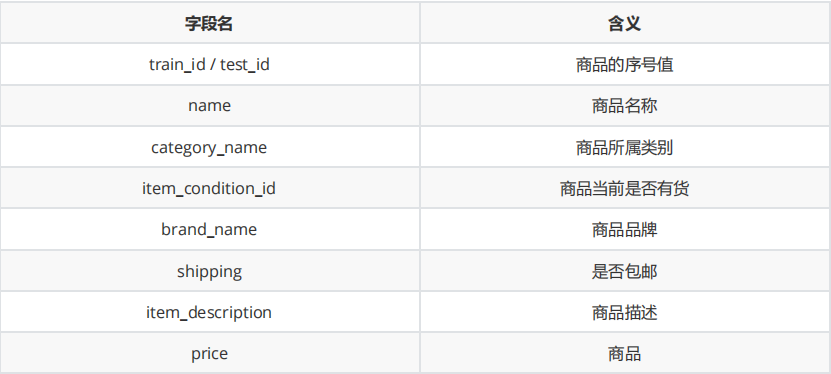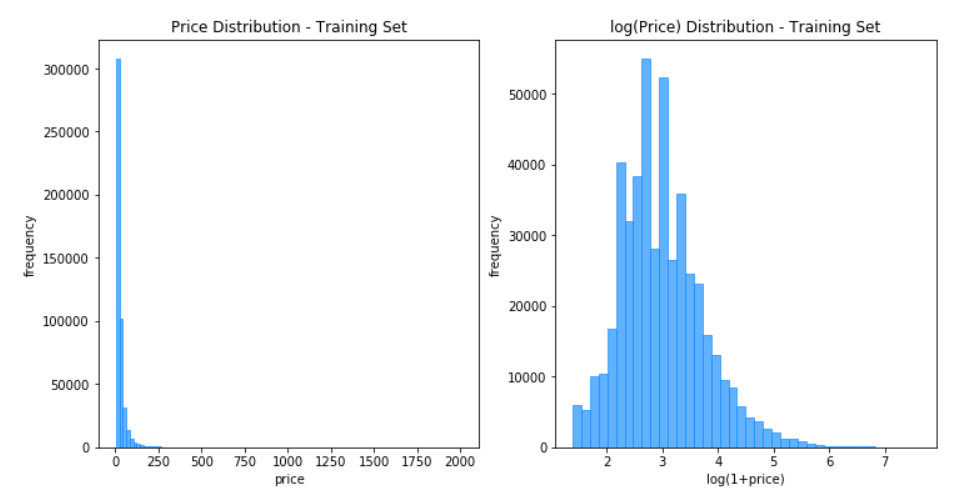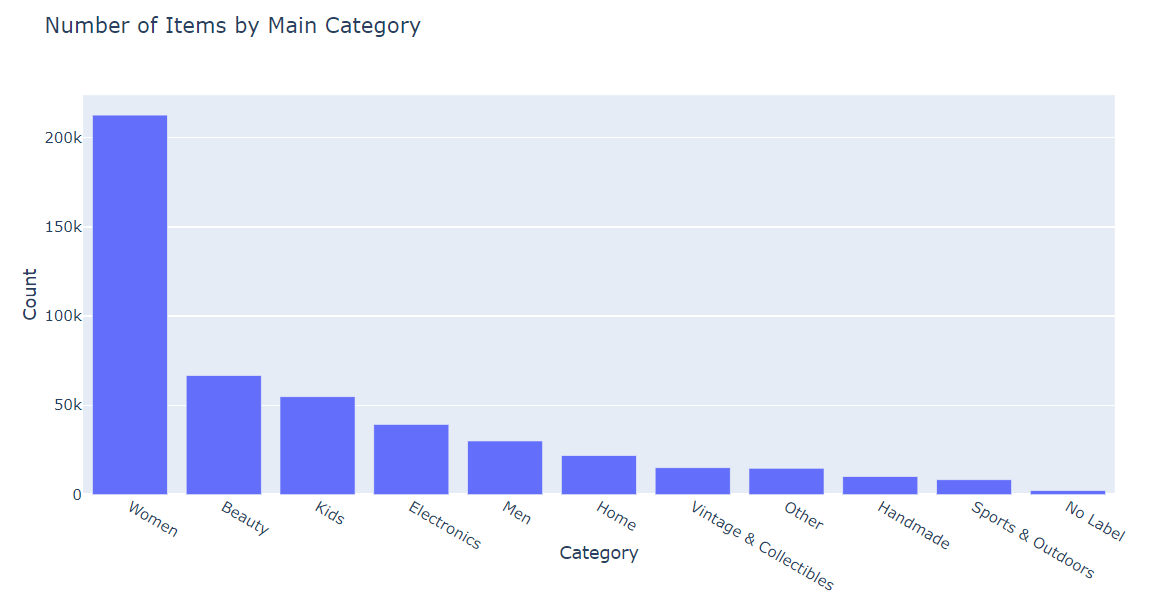Predicting the price by its description | ML Algorithms
This is a task in the course Introduction to Data Science. Our team was going to predict the price of products by their description.
Topic
Background
Considering the number of products sold online, product pricing becomes more difficult at scale. Apparel has strong seasonal pricing trends and is heavily influenced by brands, while electronics prices fluctuate based on product specifications. It is a meaningful question to help merchants effectively sell their goods by making reasonable pricing based on past information.
Target
The product description, product category and brand information is given and combined with the product price from the training data to set the price for the new product.
Obviously Versace’s clothes should be much higher in price than Metersbonwe’s clothes, and in the description of the goods, you can find a slight difference between the two descriptions.
This project aims to analyze the text information, extract the important information from the text information and derive the potential relationship with the price。
Analysis of atributes

Dataset
train.csvtraining dataset (Includeprice)test.csvtest dataset (Not includeprice) ;label_test.csv(Corresponding to the price of the test dataset)f_test.csvFinal measurement data set (Not includeprice)
Evaluation Indicators
We used Mean Squared Logarithmic Error (MSLE) to evaluate the algorithm:
Which \(n\) means the number of samples in test dataset; \(p_i\)means the predicting price of sales; \(\alpha_i\) means the real price.
Data Process
Learning sample code
The sample code given was first tried to understand the general idea of solving this problem. The main processes to solve this price prediction problem are: importing data and data exploration, data pre-processing, model construction, price prediction and measurement.
import data and exploration
Import the data and get acknowledge with it.
train_data = pd.read_csv('../data/4/train.csv', sep="\t") |
<class 'pandas.core.frame.DataFrame'> |
Data Preprocess
First of all, we need to remove price from the training data, and then remove train_id or test_id which are not useful. By looking at the data attributes above, we can see that category_name and brand_name have missing data, so the sample code is filled with missing directly.
def featureProcessing(df): |
Model Construction
First of all, the input of the model is done and the matrix of word frequencies is generated by CountVectorizer and TfidfVectorizer. Tfidf is better because the number of occurrences of each word in all field clocks is taken into account and the generated word frequency matrix is weighted.
vectorizer = FeatureUnion([ |
Predict the price by Ridge Regression.
def ridgeClassify(train_data, train_label): |
By understanding the dataset and studying the sample code, we learned that there are three angles to start with to optimize the answer to this question.
- data preprocessing: How to handle missing values? How should the attributes be combined?
- optimization when forming the word frequency matrix: adjusting the parameters of
CountVectorizerandTfidfVectorizer. - Model selection and optimization: try models other than ridge regression, adjust model parameters.
Try more models
In the sample code above, the result obtained using the ridge regression model is about 3.01. After the hints from the previous class and the online search, we are ready to try the MLP model and the Lgmb model again. After roughly trying both models, we decided to further optimize the model using MLP.
MLP
The result of MLP is 0.4430 (MSLE)
LGBM
The result of Lgbm is 0.2688 (MSLE)
MLP Combined with LGBM
<1> Preprocessing
- Import the data
train = pd.read_csv('data/train.csv', sep='\t') |
- Handling missing value
# Handling missing values |
- Feature vectorization
Use the CountVectorizer class in the sklearn library to vectorize the text features and use FeatureUnion for feature union.
vectorizer = FeatureUnion([ |
<2> Model Construction
The features were trained using the ridge regression model, the Lgbm model and the mlp model, respectively, and the solutions obtained in local tests were 3.01, 3.00, and 0.26, respectively.
- Ridge Regression
|
lgbmModel
def lgbm_classify(train_data,train_label): |
mlpModel
The MLP model consists of two fully connected layers and a dropout layer, which is essentially a network of multiple hidden layers.
def mlp_model(train_data,train_label,row_train): |
Optimization when forming word frequency matrix
In the sample code we tried to replace all CountVectorizer with TdidfVectorizer and then use the Ridge model for prediction, but the result is not much optimized, only up to 2.9.
Later, when using the MLP, we completely discarded the CountVectorizer and used only the TdidfVectorizer.
Optimize the data pre-processing process
The way we optimize the MLP, which is basically perfected above, is to try different combinations of features.
Analysis of the attributes
First I analyzed the attributes:item_condition_id 300000 non-null int64
shipping 300000 non-null int64
name 300000 non-null object
category_name 298719 non-null object
brand_name 171929 non-null object
item_description 300000 non-null object
item_condition_id and shipping are considered directly as inputs, while name, category_name, brand_name, item_description are considered for different combinations to try.
Before that, we found an example tutorial on data visualization to analyze the attributes of the data.
The optimal combination of inputs is obtained by observing the data.
train.head() |

price
By looking at the data after visualization we know why we have to dolog1ponpriceto make the distribution ofpricebetter.

category_name
Try to split the property into various subclasses and view the corresponding data.

item_description
Try different attributes combination
- simply combine the attributes together in the sample code for text analysis, i.e.
name+item_condition_id+category_name+brand_name+shipping+item_description. (6 inputs) - try
name,item_condition_id,shipping,category_name+item_description,brand_name. (5 inputs) - try
name,item_condition_id,shipping,category_name+brand_name+item_description. (4 inputs) - try
name,item_condition_id,shipping,name+category_name+brand_name+item_description. (4 inputs)
The results for the four combinations as input are very similar, except that combination 1 MSLE is around 0.4, combinations 2 and 3 are around 0.21, and combination 4 eventually runs to around 0.17. Combination 4 actually increases the weight of name to make the final result better.
Final source code and experimental results
Data preprocessing
# data preprocessing
# There are 8 attributes, remove price, train_id will have no influence on the result.
def data_preprocess(df):
df['name'] = df['name'].fillna('') + ' ' + df['brand_name'].fillna('')
df['text'] = (df['item_description'].fillna('') + ' ' + df['name'] + ' ' + df['category_name'].fillna(''))
return df[['name', 'text', 'shipping', 'item_condition_id']]Model Construction
def fit_predict(xs, y_train):
X_train, X_test = xs
# Configure the operation method of tf.Session, such as gpu operation or cpu operation
config = tf.ConfigProto(
# Set the number of threads for multiple operations in parallel
intra_op_parallelism_threads=1, use_per_session_threads=1, inter_op_parallelism_threads=1)
# Session provides the environment for Operation execution and Tensor evaluation.
with tf.Session(graph=tf.Graph(), config=config) as sess, timer('fit_predict'):
ks.backend.set_session(sess)
model_in = ks.Input(shape=(X_train.shape[1],), dtype='float32', sparse=True)
# ks.layers.Dense means the dimension of output
# Dense full connected layer, equals to add one layer directly.
# activation is the activation function.
out = ks.layers.Dense(192, activation='relu')(model_in)
out = ks.layers.Dense(64, activation='relu')(out)
out = ks.layers.Dense(64, activation='relu')(out)
out = ks.layers.Dense(1)(out)
model = ks.Model(model_in, out)
model.compile(loss='mean_squared_error', optimizer=ks.optimizers.Adam(lr=3e-3))
for i in range(3):
with timer(f'epoch {i + 1}'):
model.fit(x=X_train, y=y_train, batch_size=2 ** (11 + i), epochs=1, verbose=0)
return model.predict(X_test)[:, 0]Model training and prediction
def main():
vectorizer = make_union(# Assemble all transformers into a FeatureUnion. n_jobs means it can be done simultaneously
# FunctionTransformer implements a custom transformation with no input validation when validate=False
# TfidfVectorizer function, consider only the words in the first max_feature bits by word frequency, token_pattern='\w+' matches at least one word
make_pipeline(FunctionTransformer(itemgetter('name'), validate=False), TfidfVectorizer(max_features=100000, token_pattern='\w+')),
make_pipeline(FunctionTransformer(itemgetter('text'), validate=False), TfidfVectorizer(max_features=100000, token_pattern='\w+')),
make_pipeline(FunctionTransformer(itemgetter(['shipping', 'item_condition_id']), validate=False),
FunctionTransformer(to_records, validate=False), DictVectorizer()),
n_jobs=4)
# StandardScaler() performs data normalization. Save the parameters (mean, variance) from the training set directly using its object to transform the test set data.
y_scaler = StandardScaler()
# The with statement is used when accessing resources to ensure that the necessary "cleanup" operations are performed to release resources regardless of exceptions during use, such as automatic closure of files after use, automatic acquisition and release of locks in threads, etc.
with timer('process train'):
train = pd.read_csv('train.csv', sep='\t')
test = pd.read_csv('test.csv', sep='\t')
# remove 'price'
train = train[train['price'] > 0].reset_index(drop=True)
# normalization of price
y_train = y_scaler.fit_transform(np.log1p(train['price'].values.reshape(-1, 1)))
X_train = vectorizer.fit_transform(data_preprocess(train)).astype(np.float32)
print(f'X_train: {X_train.shape} of {X_train.dtype}')
with timer('process valid'):
X_test = vectorizer.transform(data_preprocess(test)).astype(np.float32)
with ThreadPool(processes=4) as pool:
Xb_train, Xb_test = [x.astype(np.bool).astype(np.float32) for x in [X_train, X_test]]
xs = [[Xb_train, Xb_test], [X_train, X_test]] * 2
# prediction
y_pred = np.mean(pool.map(partial(fit_predict, y_train=y_train), xs), axis=0)
y_pred = np.expm1(y_scaler.inverse_transform(y_pred.reshape(-1, 1))[:, 0])
# print(type(y_pred))
# Export prediction results to csv
test_id = np.array(range(0, len(y_pred)))
dataframe = pd.DataFrame({'test_id': test_id, 'price': y_pred})
dataframe.to_csv("res.csv", index=False, sep='\t')
# print('Valid MSLE: {:.4f}'.format(mean_squared_log_error(valid['price'], y_pred)))
The final experimental result reached 0.179.
Other optimization directions in the MLP model
- It can be observed that in the word cloud of
item_desciption, there are words such asshippingandfree, which may stand for free shipping and other meanings, and there is some duplication with theshippingattribute, and using it as a feature word to train the model will cause interference. - The information contained in a single keyword may not be comprehensive, and there may be great correlation between keywords.
- In the final model
MLPuses a four-layer perceptron, and the number of layers of the perceptron and the input size of each layer can be further tuned.
Experience
This experiment was very difficult and I didn’t know where to start.
After carefully studying the sample code given in the course and the content of data visualization and analysis, I got a preliminary understanding of both the dataset and the method of prediction.
Since I was very unfamiliar with models such as MLP and Lightgbm, I started from the input point of view and experimented with the combination of different attributes to get the final and better results.
In the following study, we should learn and understand the model more deeply, and try to create the model independently, instead of modifying other models that have been written.
Reference
[1]. https://ahmedbesbes.com/how-to-mine-newsfeed-data-and-extract-interactive-insights-in-python.html
[2]. https://github.com/pjankiewicz/mercari-solution
[3]. https://www.kaggle.com/thykhuely/mercari-interactive-eda-topic-modelling
[4]. https://wklchris.github.io/Py3-pandas.html#统计信息dfdescribe-svalue_counts--unique
[5]. https://zh.wikipedia.org/wiki/多层感知器
[6]. https://blog.csdn.net/weixin_39807102/article/details/81912566
[7]. https://github.com/maiwen/NLP
[8]. https://zh.wikipedia.org/wiki/正则表达式
[9]. https://blog.csdn.net/u012609509/article/details/72911564
[10]. https://www.kaggle.com/tunguz/more-effective-ridge-lgbm-script-lb-0-44823
[11]. https://qiita.com/kazuhirokomoda/items/1e9b7ebcacf264b2d814
